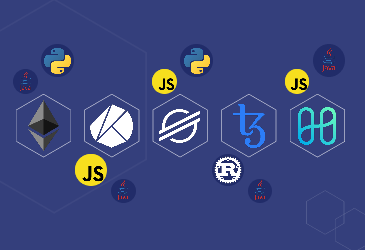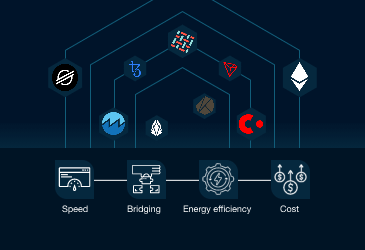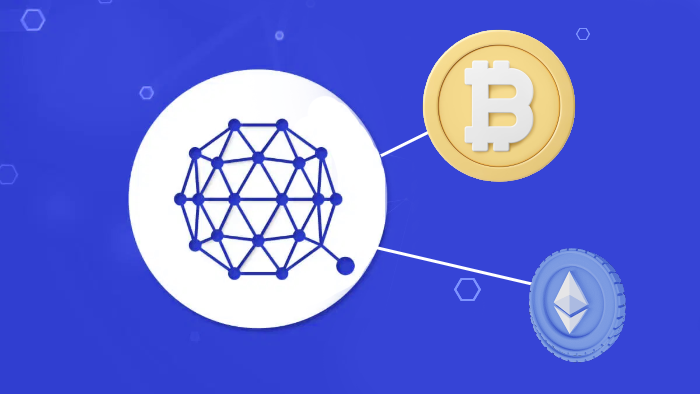
WanChain: Empowering Blockchains With Interoperability
While most blockchains today are trying to create something new and innovative, too many of them are repeating the mistakes made in the past. Each blockchain, or cluster of blockchains, exists as an isolated network that doesn’t feel connected with web3 or the future. Wanchain believes that web3’s purpose is to establish peer-to-peer interaction as the core of a networked ecosystem. After all, the purpose of a decentralized ecosystem is to allow the trustless, permissionless exchange and sharing of information.
But the question is how to make every blockchain a part of this interconnected world. The answer is to create something truly distributed and interoperable- a network of blockchains that will facilitate the exchange of data and assets. Here comes the role of Wanchain.
What is Wanchain?
Wanchain is a blockchain interoperability and decentralized finance platform that connects multiple blockchains. Interoperability is the capability of a blockchain to see, access and share information with other blockchains. Thus, Wanchain bridges isolated private and public blockchains, enabling the free exchange of data and digital assets among them. Blockchain interoperability also makes cross-chain transactions possible, making the world of blockchains more valuable for users.
In the context of computer networks, WAN is an abbreviation for Wide Area Network. Thus, the Wanchain network serves as a ‘Wide Area Network’ of blockchains to establish an interoperable, truly decentralized future that will help build extremely secure and fair solutions. With the Wanchain network, communication has become easy among blockchains that couldn’t communicate earlier. With Wanchain, you can create robust smart contracts using the Solidity programming language. Developers can not just build smart contracts on Wanchain, but also undertake other development projects that include building decentralized applications and both fungible and non-fungible tokens.
Wanchain is essentially a general public ledger that runs on Ethereum. The Wanchain network facilitates two types of transactions- cross-chain and intra-chain transactions. Incentive- and consensus-based mechanisms are used to validate cross-chain transactions. The process of cross-chain transactions on the Wanchain network begins with the participating blockchains and the assets being registered on Wanchain for unique identification. An asset registration protocol is available for this purpose.
Wanchain for the financial sector
Wanchain is a project that aims to decentralize financial services by moving all asset and value transfers onto the blockchain. Wanchain, a blockchain connecting other blockchains, facilitates value trades using proxy. The following key ingredients are what have enabled the Wanchain network to integrate successfully with legacy banking systems.
- Wanchain was originally an Ethereum ERC20 token. Now, it is a standalone hard fork network.
- Wanchain, like Ethereum, is a smart contract blockchain that hosts dApps. It is specifically designed for the financial sector.
- Wanchain uses on-chain proxy to connect blockchains to one another for facilitating quick and inexpensive asset transfers.
- Wanchain Foundation, WANlab and other developers are working together to build a thriving dApp ecosystem.
Because of these characteristics, Wanchain may be considered well-positioned for success. Wanchain is a promising blockchain network which we discuss in detail below.
The most prominent features of WanChain
Wanchain is a robust blockchain network with a multitude of amazing features. Let us look at the top five Wanchain blockchain features.
Cross-chain transactions
Wanchain has the ability to facilitate asset exchanges across multiple blockchains, which is one of its most attractive features. Let’s say John wishes to send Myra $1,000 worth of Bitcoin. However, Myra prefers Ethereum.
John could use Wanchain to send Bitcoins and have them converted to Ethereum without having to go to a central exchange. Wanchain eliminates the requirement for a third person when creating transactions like these. The result is a reduction in cost, transaction time and risk.
Makes ICOs accessible to a wider audience
The popularity of ICOs is constantly rising. However, ICOs have a major limitation: they mostly accept Bitcoin and Ethereum. This means that if you have another coin like Litecoin, you can’t contribute directly to your chosen ICO with it.
Wanchain allows organizations that issue ICOs to accept tokens from any blockchain that has been integrated into the Wanchain ecosystem. Wanchain will support more blockchains as it grows. Say, if Wanchain is capable of supporting 100 blockchains, then an ICO organized with Wanchain will be able to accept contributions from users of all these 100 blockchains.
Privacy
You are probably aware of the importance of privacy in crypto investments. Wanchain has made privacy an integral part of its ecosystem, which it makes possible by using one-time account and ring signatures.
One-time account system
Wanchain allows only a single account to be created against one wallet. Users can, however, create multiple “one-time accounts” if necessary. That means you can set up a one-time account to send 1 BTC to your friend, which will generate an additional public and a private key.
These keys can only ever be used for this one particular transaction. This makes it extremely difficult to track your or your friend’s main accounts using this1 BTC transaction.
Ring signatures
Monero users know how important ring Signatures are. Wanchain uses the Elliptic Curve Cryptography (ECC) Ring Signature Technology almost identically to Monero.
This technology hides transactions’ signatures by using multiple fake signatures in combination with the real one. This technology makes it almost impossible for a third party to find out which signature is authentic and which is fake.
Integrating traditional institutions
Wanchain White Paper states that one of Wanchain’s goals is to integrate with consortiums. We have also seen an increase in traditional institutions like banks forming consortium chains.
Consortium chains reserve the ability to update the ledger to only a selected few. This is in contrast to public blockchains like Ethereum. Banks are joining hands to create such blockchains. In the future, these chains might enable traditional investments to be made using cryptocurrency.
The blockchain has its own currency, Wancoin
Wanchain’s native cryptocurrency, Wancoin, can be used for transactions on the Wanchain blockchain.
Wanchain: Its history and overview
Wanchain Foundation, an international non-profit registered in Singapore, is currently developing Wanchain. Wanchain aims to create a decentralized financial market that uses blockchain technology. The team behind Wanchain plans to accomplish this goal by focusing its efforts on three pillars- crosschain blockchain interoperability, privacy and smart contracts. Wanchain envisions a wide range of financial service networks and a variety of use cases, including decentralized exchanges, lending, stablecoins and multi-currency settlements and payments. Jack Lu, who formerly co-founded Factom started the Wanchain Initiative in 2016.
The project supports the growth of digital assets. This includes the tokenization of traditional assets like bonds and stocks and how these will interact with existing blockchains like Bitcoin, Ethereum, and others. Wanchain has created the T-Bridge Framework, which is a universal, standard framework that allows assets and data to be exchanged between blockchains.
Private transactions can be undertaken by users using ring signatures and one-time addresses. This is a way for users to remain anonymous and to promote asset fungibility.
Wanlabs members and Wanchain core community members have joined hands to create a variety of dApps. Wanchain currently offers eight dApps, including Instant Cross and WanSwap.
Wanchain token was launched in October 2017 with an ICO. The project attracted significant interest and was sold out within a day. Current CEO Jack Lu and ex-president Dustin Byington put their previous blockchain knowledge and experiences into founding Wanchain, which now has offices in Austin, Texas, and Beijing, China. The Wanchain cryptocurrency token started trading on Binance on 23rd March 2018. It is currently available for trade on Binance, Kucoin, and Huobi. It was the 70th largest cryptocurrency company in August 2018 based on total market capitalization. This is a drop from its usual place among the top 50.
How do Wanchain’s cross-chain bridges work?
Wanchain offers a variety of cross-chain bridges, including Layer 2 Bridges, Direct Bridges and NFT Bridges.
Most of Wanchain’s Direct Bridges use the lock-mint-burn-unlock method. The Bridge Group first locks the original asset of a cross-chain transaction on the source blockchain and then mints a wrapped token on the destination blockchain. The wrapped token can be burned at any time by the user to retrieve the original asset.
If a user wishes to move 1 ETH from Ethereum to Wanchain, then the 1 ETH must be first locked on Ethereum. Then, a new token, say, wanETH will be minted on Wanchain. This 1 wanETH can, at any time, be used to obtain 1 ETH.
Layer 2 Bridges make use of decentralized liquidity pools for bridging assets. This method allows both the source and destination blockchains to have an existing pool of assets in an account managed by the Bridge Group. Cross-chain transactions are initiated by users who deposit assets to the pool on the source blockchain, and the same amount of assets then get released to the destination blockchain.
NFT bridges are customized to suit each project, though they resemble the lock-mint-burn-unlock method more. All attributes and NFT IDs are exchanged between blockchains.
Wanchain facilitates interoperability among the following blockchain
Wanchain’s cross-chain infrastructure has been in the making since 2017. It developed the world’s first decentralized Ethereum-Bitcoin bridge in early 2021. Wanchain’s non-custodial, decentralized bridges connect the following:
-
XRP Ledger
-
XDC Network
-
Wanchain
-
Tron
-
Polygon
-
Polkadot Relay Chain
-
OKC (OKX Chain)
-
Moonriver
-
Moonbeam
-
Litecoin
-
Fantom
-
Ethereum
-
EOS
-
Dogecoin
-
Clover Parachain
-
BNB Chain
-
Bitcoin
-
Avalanche C-Chain
-
Arbitrum
Wanchain’s Bridge Nodes maintain unified decentralized collateral pools that support all of Wanchain’s decentralized cross-chain bridges.
Endnote
Wanchain, a Singapore-based company, lives by its mission of connecting the world’s digital assets. The company allows applications built on its platform to access digital assets available on different blockchains and unlock the full potential of cryptocurrency and blockchain technology. With timely updates, its long-term goal to create an interconnected network that combines both public and privately owned blockchains is slowly getting fulfilled.
If you want to know the performance of the Wanchain network, its ecosystem score and ranking, the foundation tools it provides, and more, you can check out the Wanchain review and rating on Scortik.
Insights

What are SDKs? Top blockchains and their SDKs
A software development kit or SDK is a set of tools and programs utilized to build and integrate customized applications for any existing or new platform.

How to Choose a Blockchain Protocol Suitable to Your Project?
Need help choosing the right blockchain protocol for your project? Use Scortik to evaluate protocols’ overall performance and make the right choice.

Qtum- Producing the best From Ethereum and Bitcoin
This insight describes all the technical details of Qtum blockchain.